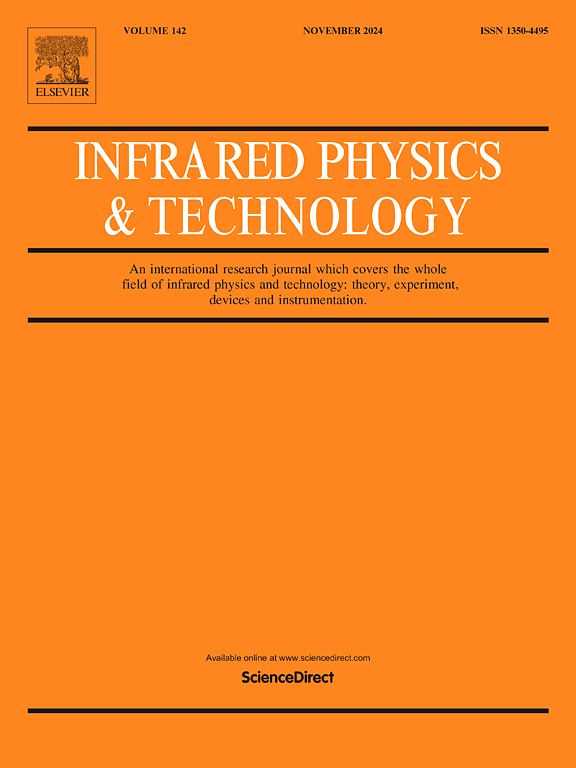通过级联可调谐法布里-珀罗腔和Sagnac干涉仪,具有低串扰温度的高灵敏度光纤应变传感器
IF 3.1
3区 物理与天体物理
Q2 INSTRUMENTS & INSTRUMENTATION
引用次数: 0
摘要
光游标效应(optical Vernier effect, OVE)由于具有显著的提高测量灵敏度的能力而受到光纤传感领域研究人员的广泛关注。据我们所知,我们首先提出并演示了一种基于OVE的高灵敏度光纤应变传感器,利用可调谐法布里-珀罗干涉仪(FPI)和Sagnac干涉仪(SI)。参考元件FPI由位于高精度电动机上的单模光纤的两个端面形成的开腔(即空腔)组成。因此,在这些高精度电机的帮助下,可以通过调整其腔长来精确控制FPI的自由光谱范围(FSR)。传感元件SI采用一段聚酰亚胺涂层熊猫型保偏光纤(PMF)通过一个3db耦合器构成。当FPI和SI的fsr相似时,它们级联产生OVE,可以放大光纤传感器的灵敏度。实验结果表明,单SI结构测量应变的灵敏度仅为10.2 pm/με。同时,级联开腔FPI和SI结构的应变灵敏度显著提高,约为199.98 pm/με。结果表明,FPI - SI级联结构的应变灵敏度比单一SI结构的应变灵敏度高19.6倍以上。所设计的光纤传感器具有0.341 με/°C的低温交叉灵敏度和良好的稳定性。因此,它在应变监测环境中的应用具有相当大的潜力。本文章由计算机程序翻译,如有差异,请以英文原文为准。
High-sensitivity optic fiber strain sensor with low crosstalk in temperature via cascading a tunable Fabry-Perot cavity and a Sagnac interferometer
The optical Vernier effect (OVE) has received much attention from researchers in the fiber sensing field due to its remarkable capability to enhance measurement sensitivity. To the best our knowledge, we first propose and demonstrate a highly sensitive optic fiber strain sensor based on OVE, utilizing a tunable Fabry-Perot interferometer (FPI) and a Sagnac interferometer (SI). The reference element FPI consists of an open cavity (i.e., air cavity) formed by two end faces of single-mode fibers positioned on high-precision electric motors. Consequently, the free spectral range (FSR) of the FPI can be precisely controlled by adjusting its cavity length with assistance from these high-precision electric motors. The sensing element SI is constructed using a section of polyimide-coated Panda-type polarization-maintaining fiber (PMF) through a 3 dB coupler. When the FSRs of the FPI and SI are similar, they are cascaded to generate OVE, which can amplify the sensitivity of the fiber sensor. The experimental results show that the sensitivity of the single SI structure for measuring the strain is only 10.2 pm/με. Meanwhile the strain sensitivity of the cascaded open-cavity FPI and SI structure is significantly increased to approximately 199.98 pm/με. It is evident that the strain sensitivity of the cascaded FPI and SI structure is more than 19.6 times higher than that of the single SI structure. The designed optic fiber sensor exhibits a low temperature cross-sensitivity of 0.341 με/°C and good stability. Hence, it can be considerable potential for applications in strain monitoring environments.
求助全文
通过发布文献求助,成功后即可免费获取论文全文。
去求助
来源期刊
CiteScore
5.70
自引率
12.10%
发文量
400
审稿时长
67 days
期刊介绍:
The Journal covers the entire field of infrared physics and technology: theory, experiment, application, devices and instrumentation. Infrared'' is defined as covering the near, mid and far infrared (terahertz) regions from 0.75um (750nm) to 1mm (300GHz.) Submissions in the 300GHz to 100GHz region may be accepted at the editors discretion if their content is relevant to shorter wavelengths. Submissions must be primarily concerned with and directly relevant to this spectral region.
Its core topics can be summarized as the generation, propagation and detection, of infrared radiation; the associated optics, materials and devices; and its use in all fields of science, industry, engineering and medicine.
Infrared techniques occur in many different fields, notably spectroscopy and interferometry; material characterization and processing; atmospheric physics, astronomy and space research. Scientific aspects include lasers, quantum optics, quantum electronics, image processing and semiconductor physics. Some important applications are medical diagnostics and treatment, industrial inspection and environmental monitoring.

 求助内容:
求助内容: 应助结果提醒方式:
应助结果提醒方式:


